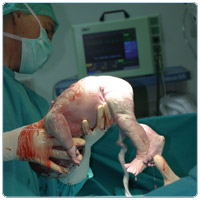Basics of caesarean sections

The Caesarean Section procedure has been dated back to the 17th century. In the 1960's and 70's it was discovered that caesarean births were often advisable even when the mother's or baby's lives were not at risk. For example deliveries that used forceps often resulted in problems, when a caesarean would have been the preferable option. However due to the safety associated with this procedure, concern is now being expressed as to the quantities of caesareans that are being performed, about a third of all births.
 What is a Caesarean Section?
What is a Caesarean Section?
This is a surgical procedure which is used to deliver a baby through the abdominal and uterine wall.
Why is a Caesarean Section done?
When a vaginal birth is impossible or dangerous. This can mean when the baby is in distress, when the mother is too exhausted to keep going and when the baby is in the breech position.
Will you be awake during a Caesarean Section?
It is usually done under spinal or epidural anesthesia. Which means that you will be awake but will not feel pain.
Risks of a Caesarean Section:
This is a major operation so there are risks. Some possible risks are thrombophlebitis, uterine infection, urinary tract infection, and complications associated with anesthesia. However there have been many improvements to this operation making it safe.
When do you need a caesarean?
• Women that have had a caesarean in the past will be likely to have another with their next baby due to the possibility of the scar (from the last caesarean) rupturing during labour. But this is dependent on the type of incision that the last caesarean had. There is less chance of rupture if the scar is horizontal (side to side) this is called a transverse lower uterine incision.
• Breech birth under certain circumstances.
• Failure to progress with labour Dystocia, prolonged labour, arrest of labour, uterine inertia, failed induction, failed forceps.
• Fetal distress.
• Toxemia Hypertension, placental abruption, placental insufficiency, premature birth, low birth weight.


